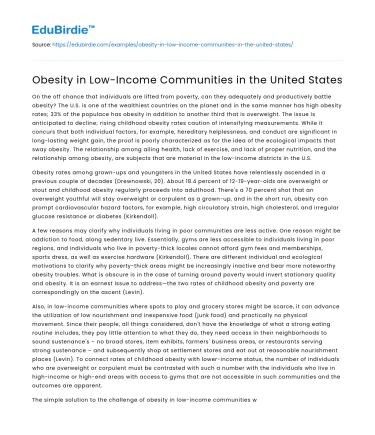On the off chance that individuals are lifted from poverty, can they adequately and productively battle obesity? The U.S. is one of the wealthiest countries on the planet and in the same manner has high obesity rates; 33% of the populace has obesity in addition to another third that is overweight. The issue is anticipated to decline; rising childhood obesity rates caution of intensifying measurements. While it concurs that both individual factors, for example, hereditary helplessness, and conduct are significant in long-lasting weight gain, the proof is poorly characterized as for the idea of the ecological impacts that sway obesity. The relationship among ailing health, lack of exercise, and lack of proper nutrition, and the relationship among obesity, are subjects that are material in the low-income districts in the U.S.
Obesity rates among grown-ups and youngsters in the United States have relentlessly ascended in a previous couple of decades (Drewnowski, 20). About 18.4 percent of 12-19-year-olds are overweight or stout and childhood obesity regularly proceeds into adulthood. There's a 70 percent shot that an overweight youthful will stay overweight or corpulent as a grown-up, and in the short run, obesity can prompt cardiovascular hazard factors, for example, high circulatory strain, high cholesterol, and irregular glucose resistance or diabetes (Kirkendoll).
A few reasons may clarify why individuals living in poor communities are less active. One reason might be addiction to food, along sedentary live. Essentially, gyms are less accessible to individuals living in poor regions, and individuals who live in poverty-thick locales cannot afford gym fees and memberships, sports dress, as well as exercise hardware (Kirkendoll). There are different individual and ecological motivations to clarify why poverty-thick areas might be increasingly inactive and bear more noteworthy obesity troubles. What is obscure is in the case of turning around poverty would invert stationary quality and obesity. It is an earnest issue to address—the two rates of childhood obesity and poverty are correspondingly on the ascent (Levin).
Also, in low-income communities where spots to play and grocery stores might be scarce, it can advance the utilization of low nourishment and inexpensive food (junk food) and practically no physical movement. Since their people, all things considered, don't have the knowledge of what a strong eating routine includes, they pay little attention to what they do, they need access in their neighborhoods to sound sustenance's – no broad stores, item exhibits, farmers' business areas, or restaurants serving strong sustenance – and subsequently shop at settlement stores and eat out at reasonable nourishment places (Levin). To connect rates of childhood obesity with lower-income status, the number of individuals who are overweight or corpulent must be contrasted with such a number with the individuals who live in high-income or high-end areas with access to gyms that are not accessible in such communities and the outcomes are apparent.
The simple solution to the challenge of obesity in low-income communities would hence be making accessible convenience stores in the areas simply like in urban areas, instruction on what includes a healthy diet, looking for options in contrast to the inexpensive food stores, and upholding for change of menu and diets in cheap food stores among others (Levin). The forceful and unreliable condition that describes life in city life keeps the poor from taking part in physical exercise, and the arrangement of these administrations in these regions would go far in explaining these difficulties in low-income communities. Likewise, the individuals who live in these zones generally get less data on the wellbeing and personal satisfaction advantages of activity, subsequently giving these would upgrade their insight and improve how this is battled in certain fronts. Equity in access to wellbeing advancement messages, wellbeing instruction, and sufficient social insurance administrations will make it exceptionally simple to know the significance of changes in conduct expected to accomplish a healthier way of life (Flegal, 20).
The above arrangements have worked in bringing awareness in the high-income communities since these gyms are effectively open to them. Also, likewise, some different activities, for example, environmental change mindfulness, HIV/Aids battles, common mindfulness and scope of others have in every case totally pegged their crusades on giving data to the general population and directing city instruction. In this way when all these are grasped, it is certain that the issue of obesity will be explained and the hazard in low-income communities in the U.S. totally reduced and attainable the Universal objectives by the World Health Organization and different elements worried about Public Health (Drewnowski, 20).
To finish up, it is conceivable that the issue of obesity in low-income communities be tackled, and as observed, the arrangements lie solidly with what the current administration and government bodies worried about Public Health will do, and these incorporate, yet not constrained to equity in access to wellbeing and educating the public, wellbeing training, and satisfactory social insurance administrations will make it exceptionally simple to know the significance of changes in conduct expected to accomplish a healthier way of life, instruction on what includes a healthy diet, looking for options in contrast to the cheap food stores, and upholding a change of menu and diets in inexpensive fast food restaurants among others.






 Stuck on your essay?
Stuck on your essay?

